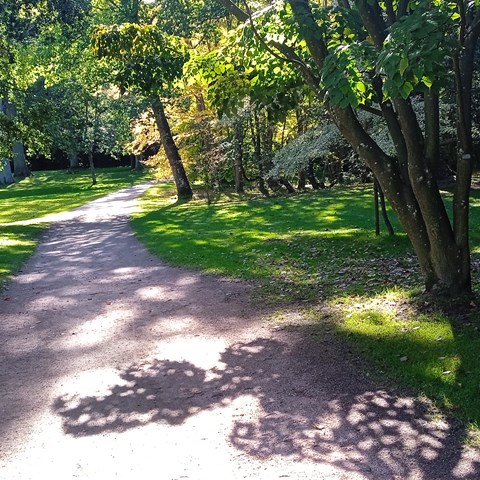Contact
Email: nafsymposium2024@slu.se

We invite teachers, researchers and PhD-students to the 2024 NAF/NAAR Symposium to gather around the “health” status of contemporary landscapes and architecture. All forms of needs concerning organizational behaviour are just as welcome as ideas for future solutions.
The symposium takes place on September 19-20, 2024, in Alnarp, Sweden. Key-note lectures will be provided and you are invited to send in your abstract referring to any of the tracks below. The organizational committee reserves the right to adjust the number and the final titles of the tracks after having evaluated the abstracts.
Changes in ‘Nordic’ design discourse and theory
Theory on design for urbanity, landscape and architecture is, at its best, a rich, broad and vibrant world of writings and ideas, crucial for providing understanding and developments of design work process and practice. However, the understanding of what ‘design theory’ is differs, and it can sometimes be perceived as detached and falling short in the face of urgent contemporary challenges that seem to demand quick and straightforward answers. Given current changes – cultural, ecological, or political – it becomes worth reflecting upon how landscape-relevant theory, as well as thereby associated discourses at large, is keeping up with the pace of the world. In particular, this track picks up on the 2020 NAF/NAAR Symposium’s focus on ‘northernness’, and continues the wish to shed light on and discuss the specificities of the Nordic countries as a context. How is design theory changing and maintaining its relevance, and is there anything ‘nordic’ about how this happens? What discourses do we seem to be leaving behind, and what can be expected to enter tomorrow? How may this matter for the life and death of great Nordic landscapes? For this part of the symposium, we invite any project/scholar that can contribute to a fruitful discussion and re-wording of design theory and associated discourses.
Keywords: design theory and discourse, design method, design process, northernness
Collaborative actions for tomorrow
More than ever, the world demands that we recognize our capacity for collaboration. Only through collaboration can we tackle the challenges we – as cultures, as groups, as individuals – face today and tomorrow. For a future sustainable social development, collaboration across subject boundaries is crucial, as do collaboration between academia, practice, policy makers, citizens, and other spheres of society. What can the shared methods and common methodological approaches for the collaborative actions of tomorrow be? How can participatory processes, collaboration with municipalities and/or companies, and new ways of cross-disciplinary be tested and developed to impact and improve the actions needed for a lasting future? What is, and what could be, the contribution of the landscape architect, the architect, and the planner, in collaborations? This track will focus on cooperative actions between various disciplines and actors to promote the development of sustainable landscapes and cities.
Keywords: multi-trans and interdisciplinary, participatory processes, democracy
The green energy transition and climate change
Will the available land in and around our cities be sufficient when considering the urgent need for both protecting ourselves from the effects of climate change, and the green energy transition? Solar and wind farms are to a great extent being located on the very same lands where we need to produce our future food. At the same time, cities are sprawling while more land would need to be set aside both to secure biodiversity, and to prevent the risk of flooding due to rising sea levels. Can a green energy transition be further supported through planning and design actions that reduce or redistribute energy needs and uses? This track will focus on the many challenges provided by climate change and the green energy transition.
Keywords: green energy transition, climate change, sustainable urban-rural interaction, regenerative design
The great Nordic urban-scapes of the future
Within this theme, we would like to encourage you to reconsider what a city landscape is; i.e. contributions that blur the lines between rural and urban,nature and culture, productive (production) forests and recreational areas, between “mixed use vibrant environments” and landscapes of material transformation. The Diffuse City (La Citta Diffusa) by Francesco Indovina, and The In-Between City (Zwischenstadt) by Thomas Sieverts, are both studies addressing critical aspects of a city landscape. They share a common concern about the evolving urban landscape, spatial dynamics, and the challenges posed by uncontrolled growth and spatial inequalities. Indovina (1990) investigates processes causing fragmented, sprawled, and low-density urban forms. Sieverts (1997) highlights the need for flexible and adaptable planning strategies to accommodate in-between areas of the city. Sharon Zukin (1995) further shows how urbanity and urban culture, also in denser ‘mixed use’ environments, increasingly has become defined as spaces of leisure and consumption, where anything challenging such a character and activities tends to be pushed out, suppressed, or excluded. Where are the factories, energy forests, and mines in our concepts of urbanity in the Nordic countries? This is a theme that embraces “multi-functionality” in more challenging and provoking ways, while searching for new landscape typologies.
Keywords: urbanity, rurality, multi-functionality, experience versus function, landscape typologies
References
Sieverts, T. (2022). Zwischenstadt (In-Between City) (1997). In: Barcelloni Corte, M., Viganò, P. (eds) The Horizontal Metropolis. Springer, Cham.
Undovina, F. (1997). La Citta Diffusa (The Diffuse City), “Quaderno Caest” n. 1. IUVA.
Zukin,S.(1995).The Cultures of Cities. Oxford:Blackwell.
Important dates and deadlines
Call for papers: 1 November 2023
Abstract deadline: 15 February 2024
Full paper: 23 August 2024
Symposium: 19–20 September 2024
Links:
Email: nafsymposium2024@slu.se